Detailed Report on Tesco's Business Operations and Strategies
VerifiedAdded on 2020/12/09
|8
|1698
|455
Report
AI Summary
This report provides a detailed analysis of Tesco's business operations, encompassing various aspects of its functioning. It begins by introducing the core elements of business operations and then delves into Tesco's practices. The report covers the importance of accounting for business success, the functions of the Human Resource department, and key features of employment legislation. It includes information on profit and loss accounts, the roles of team members, stages of team development, and different motivation theories. Furthermore, it explores various leadership styles and concludes with a comprehensive overview of the company's operations, supported by relevant references. The report aims to provide insights into how Tesco manages its business environment, emphasizing its commitment to delivering high-quality services to its customers and maintaining a successful organizational structure.
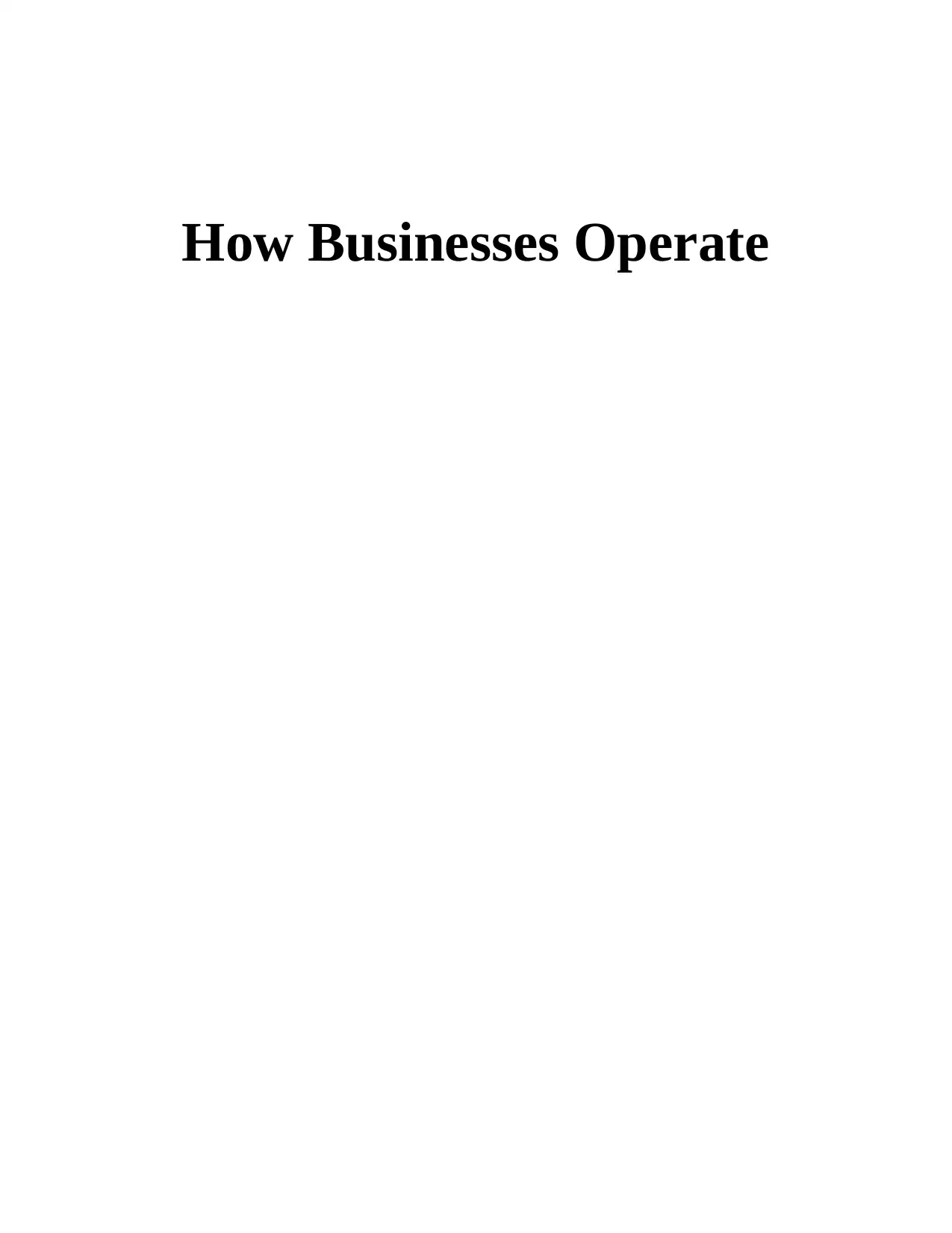
How Businesses Operate
Paraphrase This Document
Need a fresh take? Get an instant paraphrase of this document with our AI Paraphraser
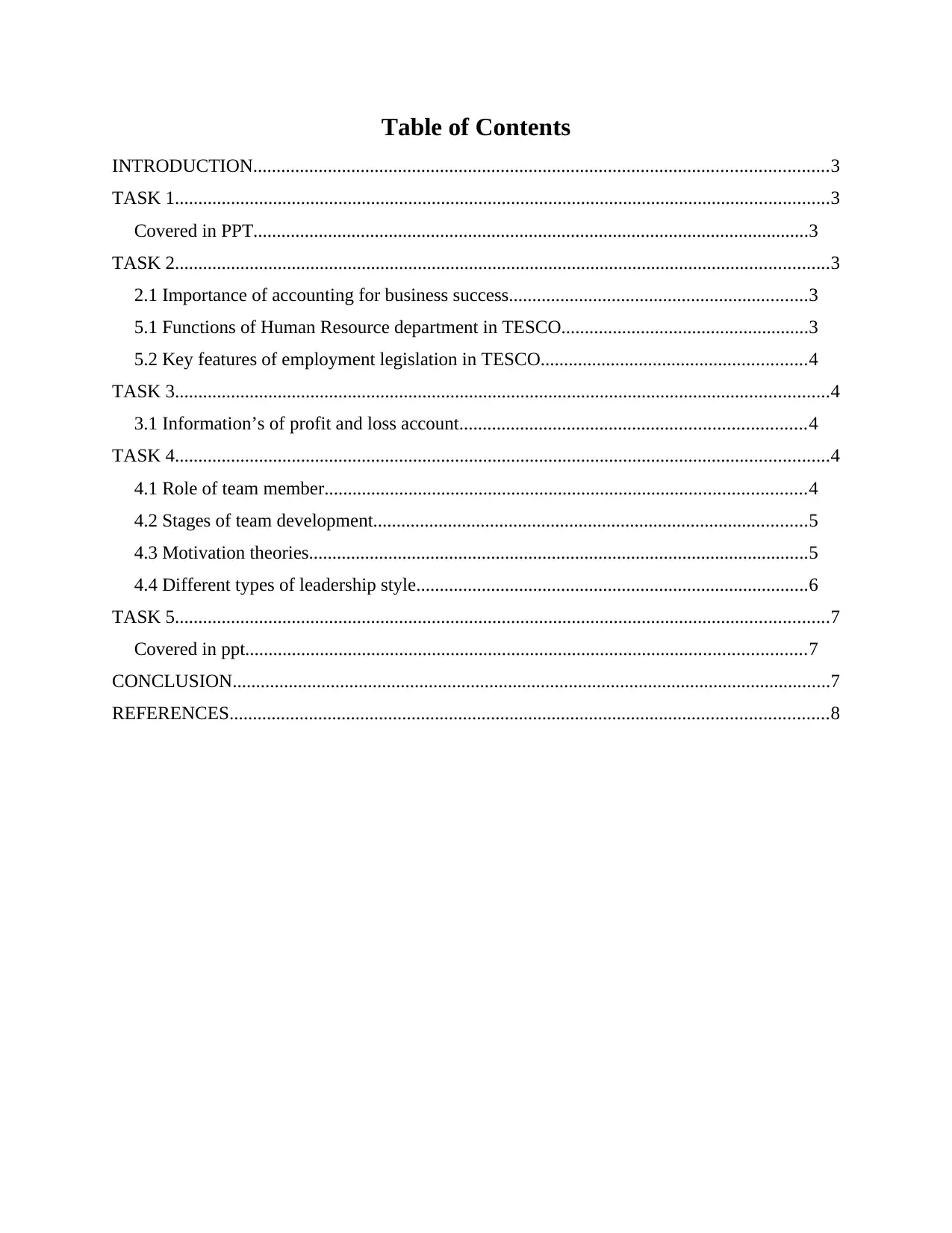
Table of Contents
INTRODUCTION...........................................................................................................................3
TASK 1............................................................................................................................................3
Covered in PPT.......................................................................................................................3
TASK 2............................................................................................................................................3
2.1 Importance of accounting for business success................................................................3
5.1 Functions of Human Resource department in TESCO.....................................................3
5.2 Key features of employment legislation in TESCO.........................................................4
TASK 3............................................................................................................................................4
3.1 Information’s of profit and loss account..........................................................................4
TASK 4............................................................................................................................................4
4.1 Role of team member.......................................................................................................4
4.2 Stages of team development.............................................................................................5
4.3 Motivation theories...........................................................................................................5
4.4 Different types of leadership style....................................................................................6
TASK 5............................................................................................................................................7
Covered in ppt........................................................................................................................7
CONCLUSION................................................................................................................................7
REFERENCES................................................................................................................................8
INTRODUCTION...........................................................................................................................3
TASK 1............................................................................................................................................3
Covered in PPT.......................................................................................................................3
TASK 2............................................................................................................................................3
2.1 Importance of accounting for business success................................................................3
5.1 Functions of Human Resource department in TESCO.....................................................3
5.2 Key features of employment legislation in TESCO.........................................................4
TASK 3............................................................................................................................................4
3.1 Information’s of profit and loss account..........................................................................4
TASK 4............................................................................................................................................4
4.1 Role of team member.......................................................................................................4
4.2 Stages of team development.............................................................................................5
4.3 Motivation theories...........................................................................................................5
4.4 Different types of leadership style....................................................................................6
TASK 5............................................................................................................................................7
Covered in ppt........................................................................................................................7
CONCLUSION................................................................................................................................7
REFERENCES................................................................................................................................8
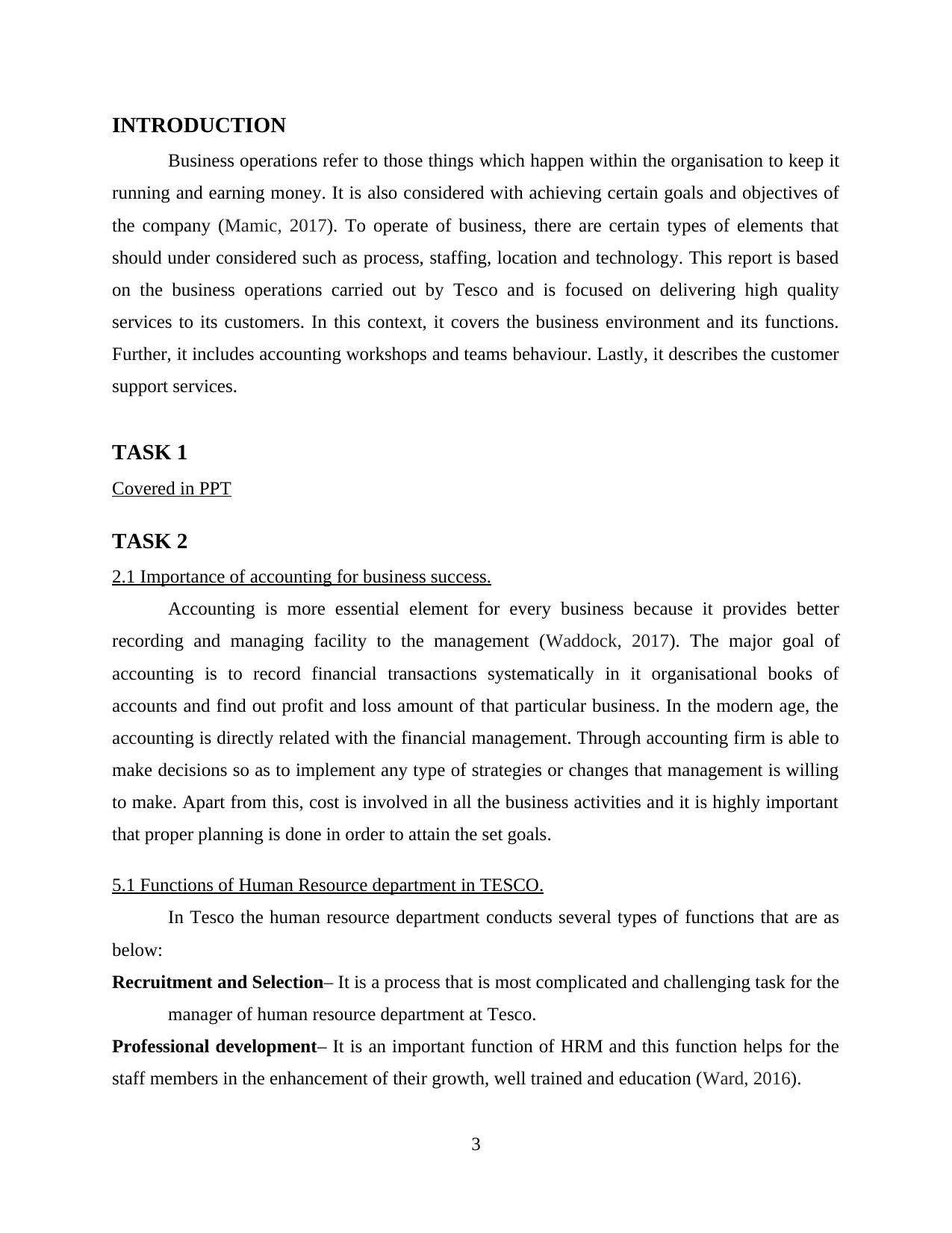
INTRODUCTION
Business operations refer to those things which happen within the organisation to keep it
running and earning money. It is also considered with achieving certain goals and objectives of
the company (Mamic, 2017). To operate of business, there are certain types of elements that
should under considered such as process, staffing, location and technology. This report is based
on the business operations carried out by Tesco and is focused on delivering high quality
services to its customers. In this context, it covers the business environment and its functions.
Further, it includes accounting workshops and teams behaviour. Lastly, it describes the customer
support services.
TASK 1
Covered in PPT
TASK 2
2.1 Importance of accounting for business success.
Accounting is more essential element for every business because it provides better
recording and managing facility to the management (Waddock, 2017). The major goal of
accounting is to record financial transactions systematically in it organisational books of
accounts and find out profit and loss amount of that particular business. In the modern age, the
accounting is directly related with the financial management. Through accounting firm is able to
make decisions so as to implement any type of strategies or changes that management is willing
to make. Apart from this, cost is involved in all the business activities and it is highly important
that proper planning is done in order to attain the set goals.
5.1 Functions of Human Resource department in TESCO.
In Tesco the human resource department conducts several types of functions that are as
below:
Recruitment and Selection– It is a process that is most complicated and challenging task for the
manager of human resource department at Tesco.
Professional development– It is an important function of HRM and this function helps for the
staff members in the enhancement of their growth, well trained and education (Ward, 2016).
3
Business operations refer to those things which happen within the organisation to keep it
running and earning money. It is also considered with achieving certain goals and objectives of
the company (Mamic, 2017). To operate of business, there are certain types of elements that
should under considered such as process, staffing, location and technology. This report is based
on the business operations carried out by Tesco and is focused on delivering high quality
services to its customers. In this context, it covers the business environment and its functions.
Further, it includes accounting workshops and teams behaviour. Lastly, it describes the customer
support services.
TASK 1
Covered in PPT
TASK 2
2.1 Importance of accounting for business success.
Accounting is more essential element for every business because it provides better
recording and managing facility to the management (Waddock, 2017). The major goal of
accounting is to record financial transactions systematically in it organisational books of
accounts and find out profit and loss amount of that particular business. In the modern age, the
accounting is directly related with the financial management. Through accounting firm is able to
make decisions so as to implement any type of strategies or changes that management is willing
to make. Apart from this, cost is involved in all the business activities and it is highly important
that proper planning is done in order to attain the set goals.
5.1 Functions of Human Resource department in TESCO.
In Tesco the human resource department conducts several types of functions that are as
below:
Recruitment and Selection– It is a process that is most complicated and challenging task for the
manager of human resource department at Tesco.
Professional development– It is an important function of HRM and this function helps for the
staff members in the enhancement of their growth, well trained and education (Ward, 2016).
3
⊘ This is a preview!⊘
Do you want full access?
Subscribe today to unlock all pages.

Trusted by 1+ million students worldwide
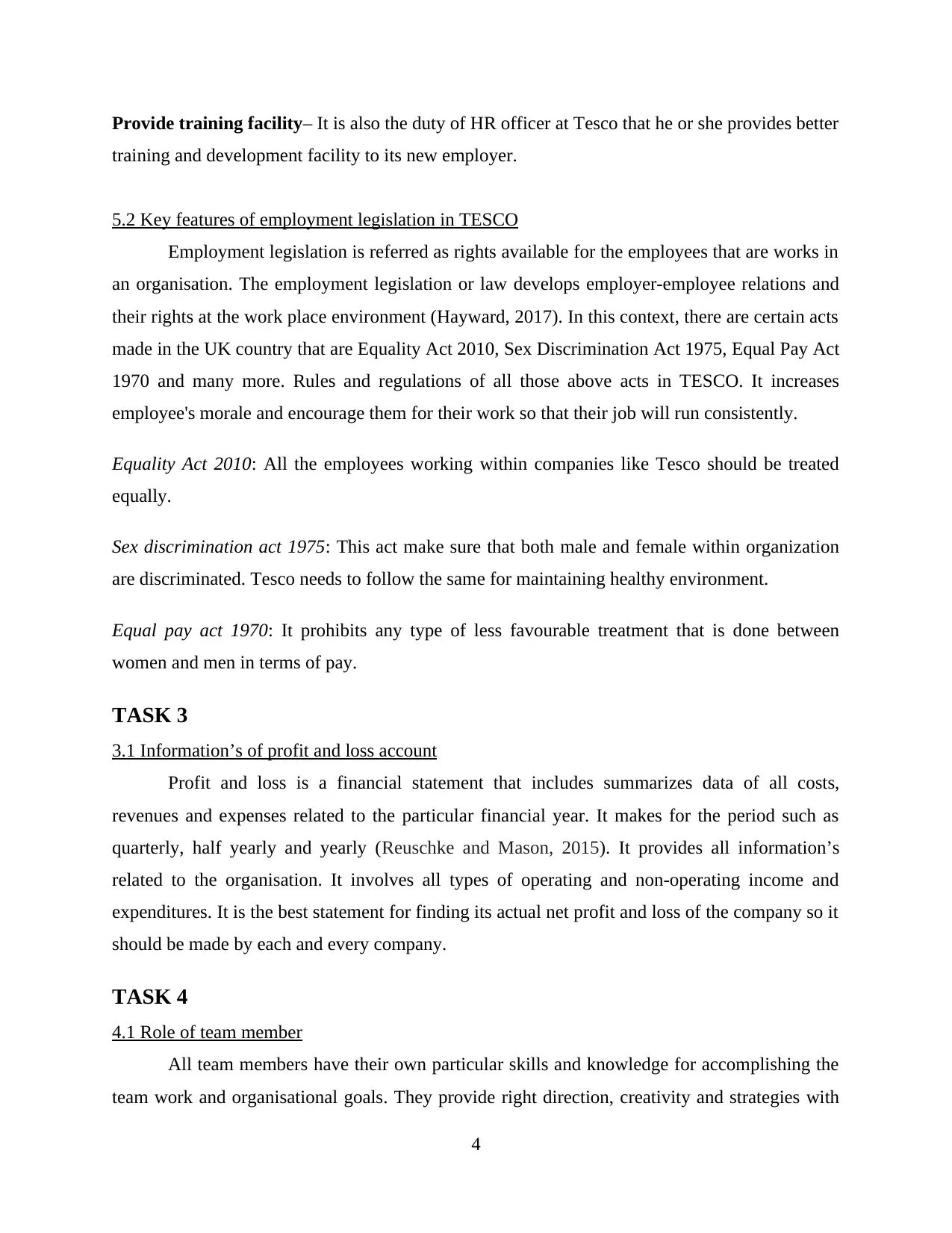
Provide training facility– It is also the duty of HR officer at Tesco that he or she provides better
training and development facility to its new employer.
5.2 Key features of employment legislation in TESCO
Employment legislation is referred as rights available for the employees that are works in
an organisation. The employment legislation or law develops employer-employee relations and
their rights at the work place environment (Hayward, 2017). In this context, there are certain acts
made in the UK country that are Equality Act 2010, Sex Discrimination Act 1975, Equal Pay Act
1970 and many more. Rules and regulations of all those above acts in TESCO. It increases
employee's morale and encourage them for their work so that their job will run consistently.
Equality Act 2010: All the employees working within companies like Tesco should be treated
equally.
Sex discrimination act 1975: This act make sure that both male and female within organization
are discriminated. Tesco needs to follow the same for maintaining healthy environment.
Equal pay act 1970: It prohibits any type of less favourable treatment that is done between
women and men in terms of pay.
TASK 3
3.1 Information’s of profit and loss account
Profit and loss is a financial statement that includes summarizes data of all costs,
revenues and expenses related to the particular financial year. It makes for the period such as
quarterly, half yearly and yearly (Reuschke and Mason, 2015). It provides all information’s
related to the organisation. It involves all types of operating and non-operating income and
expenditures. It is the best statement for finding its actual net profit and loss of the company so it
should be made by each and every company.
TASK 4
4.1 Role of team member
All team members have their own particular skills and knowledge for accomplishing the
team work and organisational goals. They provide right direction, creativity and strategies with
4
training and development facility to its new employer.
5.2 Key features of employment legislation in TESCO
Employment legislation is referred as rights available for the employees that are works in
an organisation. The employment legislation or law develops employer-employee relations and
their rights at the work place environment (Hayward, 2017). In this context, there are certain acts
made in the UK country that are Equality Act 2010, Sex Discrimination Act 1975, Equal Pay Act
1970 and many more. Rules and regulations of all those above acts in TESCO. It increases
employee's morale and encourage them for their work so that their job will run consistently.
Equality Act 2010: All the employees working within companies like Tesco should be treated
equally.
Sex discrimination act 1975: This act make sure that both male and female within organization
are discriminated. Tesco needs to follow the same for maintaining healthy environment.
Equal pay act 1970: It prohibits any type of less favourable treatment that is done between
women and men in terms of pay.
TASK 3
3.1 Information’s of profit and loss account
Profit and loss is a financial statement that includes summarizes data of all costs,
revenues and expenses related to the particular financial year. It makes for the period such as
quarterly, half yearly and yearly (Reuschke and Mason, 2015). It provides all information’s
related to the organisation. It involves all types of operating and non-operating income and
expenditures. It is the best statement for finding its actual net profit and loss of the company so it
should be made by each and every company.
TASK 4
4.1 Role of team member
All team members have their own particular skills and knowledge for accomplishing the
team work and organisational goals. They provide right direction, creativity and strategies with
4
Paraphrase This Document
Need a fresh take? Get an instant paraphrase of this document with our AI Paraphraser
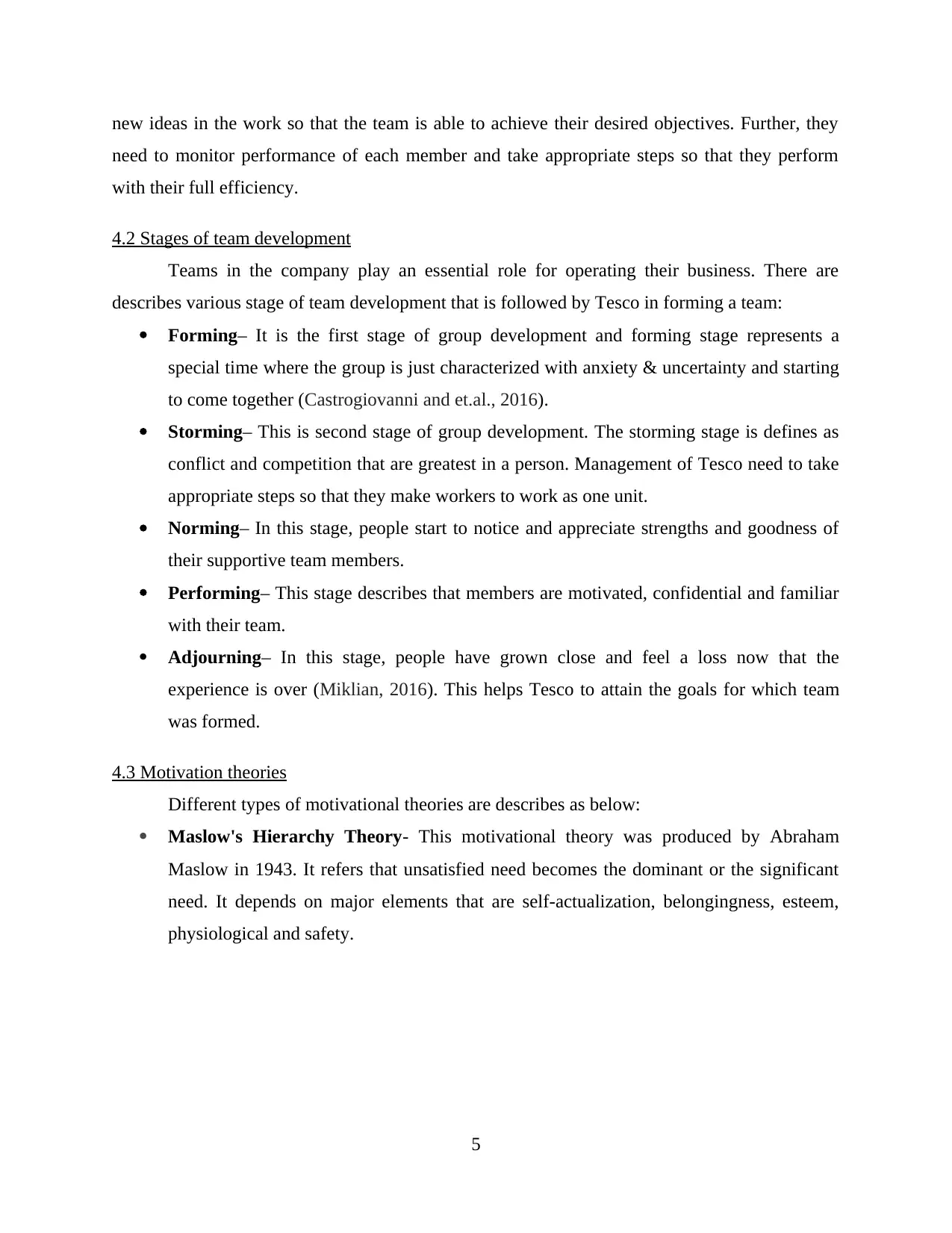
new ideas in the work so that the team is able to achieve their desired objectives. Further, they
need to monitor performance of each member and take appropriate steps so that they perform
with their full efficiency.
4.2 Stages of team development
Teams in the company play an essential role for operating their business. There are
describes various stage of team development that is followed by Tesco in forming a team:
Forming– It is the first stage of group development and forming stage represents a
special time where the group is just characterized with anxiety & uncertainty and starting
to come together (Castrogiovanni and et.al., 2016).
Storming– This is second stage of group development. The storming stage is defines as
conflict and competition that are greatest in a person. Management of Tesco need to take
appropriate steps so that they make workers to work as one unit.
Norming– In this stage, people start to notice and appreciate strengths and goodness of
their supportive team members.
Performing– This stage describes that members are motivated, confidential and familiar
with their team.
Adjourning– In this stage, people have grown close and feel a loss now that the
experience is over (Miklian, 2016). This helps Tesco to attain the goals for which team
was formed.
4.3 Motivation theories
Different types of motivational theories are describes as below:
Maslow's Hierarchy Theory- This motivational theory was produced by Abraham
Maslow in 1943. It refers that unsatisfied need becomes the dominant or the significant
need. It depends on major elements that are self-actualization, belongingness, esteem,
physiological and safety.
5
need to monitor performance of each member and take appropriate steps so that they perform
with their full efficiency.
4.2 Stages of team development
Teams in the company play an essential role for operating their business. There are
describes various stage of team development that is followed by Tesco in forming a team:
Forming– It is the first stage of group development and forming stage represents a
special time where the group is just characterized with anxiety & uncertainty and starting
to come together (Castrogiovanni and et.al., 2016).
Storming– This is second stage of group development. The storming stage is defines as
conflict and competition that are greatest in a person. Management of Tesco need to take
appropriate steps so that they make workers to work as one unit.
Norming– In this stage, people start to notice and appreciate strengths and goodness of
their supportive team members.
Performing– This stage describes that members are motivated, confidential and familiar
with their team.
Adjourning– In this stage, people have grown close and feel a loss now that the
experience is over (Miklian, 2016). This helps Tesco to attain the goals for which team
was formed.
4.3 Motivation theories
Different types of motivational theories are describes as below:
Maslow's Hierarchy Theory- This motivational theory was produced by Abraham
Maslow in 1943. It refers that unsatisfied need becomes the dominant or the significant
need. It depends on major elements that are self-actualization, belongingness, esteem,
physiological and safety.
5
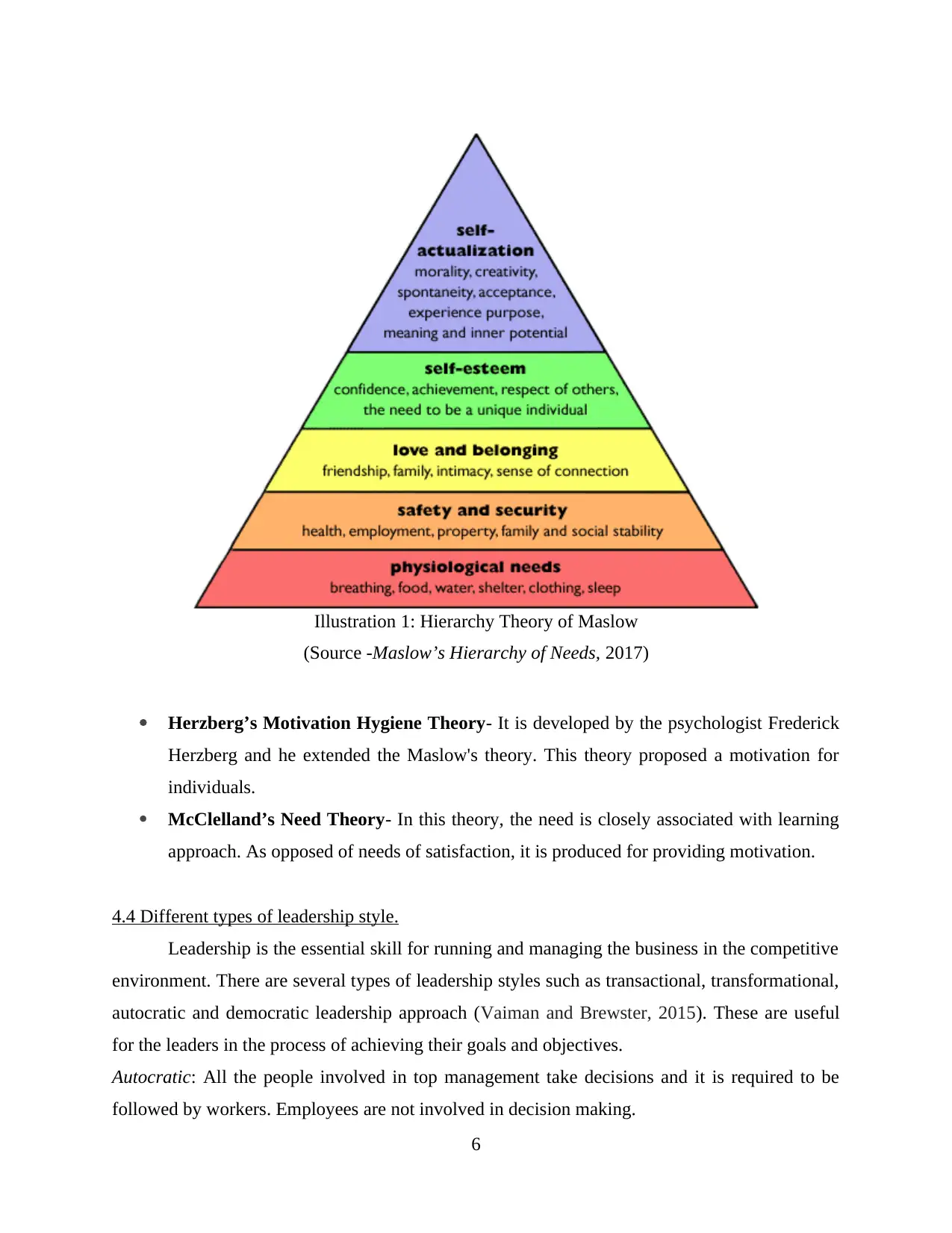
Herzberg’s Motivation Hygiene Theory- It is developed by the psychologist Frederick
Herzberg and he extended the Maslow's theory. This theory proposed a motivation for
individuals.
McClelland’s Need Theory- In this theory, the need is closely associated with learning
approach. As opposed of needs of satisfaction, it is produced for providing motivation.
4.4 Different types of leadership style.
Leadership is the essential skill for running and managing the business in the competitive
environment. There are several types of leadership styles such as transactional, transformational,
autocratic and democratic leadership approach (Vaiman and Brewster, 2015). These are useful
for the leaders in the process of achieving their goals and objectives.
Autocratic: All the people involved in top management take decisions and it is required to be
followed by workers. Employees are not involved in decision making.
6
Illustration 1: Hierarchy Theory of Maslow
(Source -Maslow’s Hierarchy of Needs, 2017)
Herzberg and he extended the Maslow's theory. This theory proposed a motivation for
individuals.
McClelland’s Need Theory- In this theory, the need is closely associated with learning
approach. As opposed of needs of satisfaction, it is produced for providing motivation.
4.4 Different types of leadership style.
Leadership is the essential skill for running and managing the business in the competitive
environment. There are several types of leadership styles such as transactional, transformational,
autocratic and democratic leadership approach (Vaiman and Brewster, 2015). These are useful
for the leaders in the process of achieving their goals and objectives.
Autocratic: All the people involved in top management take decisions and it is required to be
followed by workers. Employees are not involved in decision making.
6
Illustration 1: Hierarchy Theory of Maslow
(Source -Maslow’s Hierarchy of Needs, 2017)
⊘ This is a preview!⊘
Do you want full access?
Subscribe today to unlock all pages.

Trusted by 1+ million students worldwide
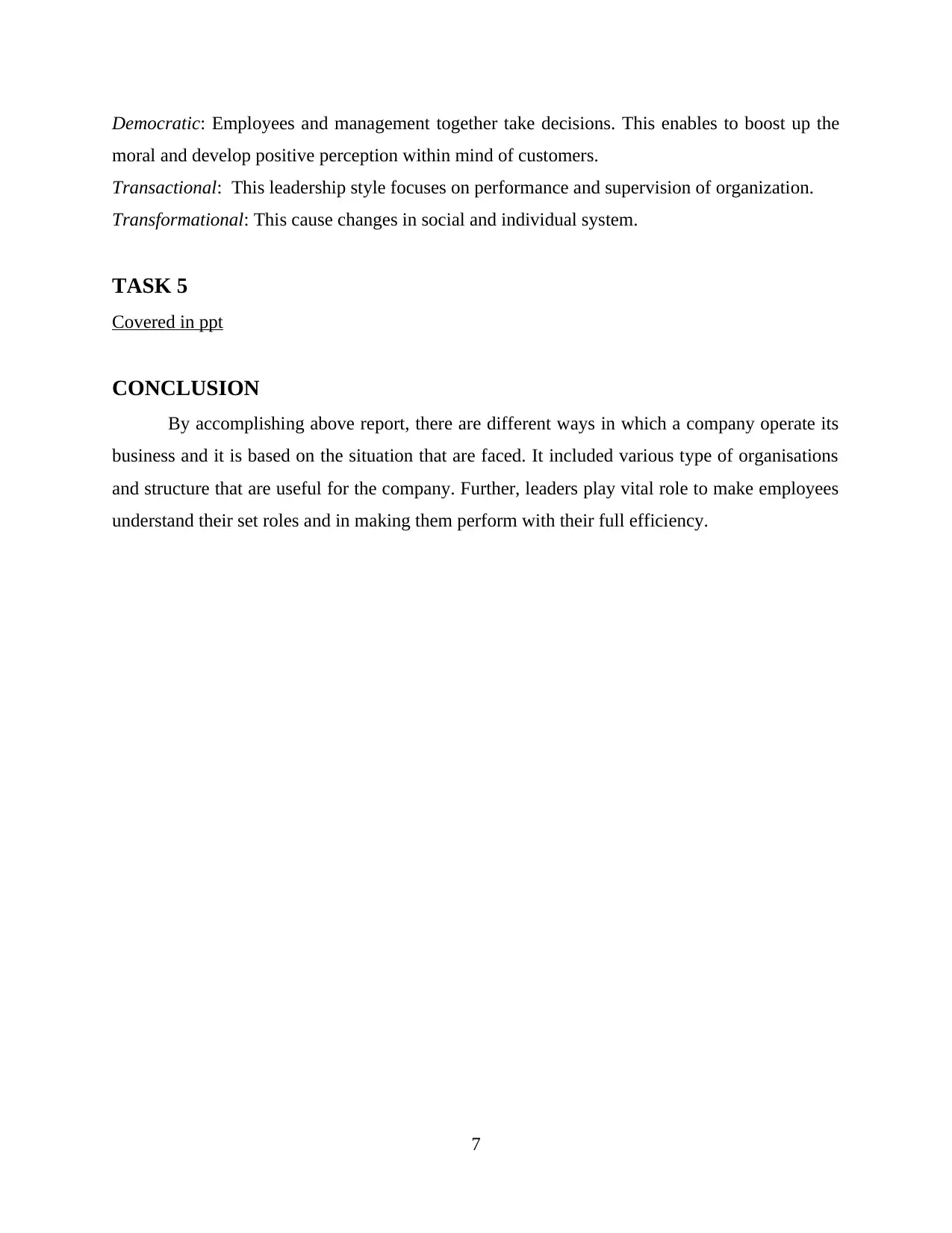
Democratic: Employees and management together take decisions. This enables to boost up the
moral and develop positive perception within mind of customers.
Transactional: This leadership style focuses on performance and supervision of organization.
Transformational: This cause changes in social and individual system.
TASK 5
Covered in ppt
CONCLUSION
By accomplishing above report, there are different ways in which a company operate its
business and it is based on the situation that are faced. It included various type of organisations
and structure that are useful for the company. Further, leaders play vital role to make employees
understand their set roles and in making them perform with their full efficiency.
7
moral and develop positive perception within mind of customers.
Transactional: This leadership style focuses on performance and supervision of organization.
Transformational: This cause changes in social and individual system.
TASK 5
Covered in ppt
CONCLUSION
By accomplishing above report, there are different ways in which a company operate its
business and it is based on the situation that are faced. It included various type of organisations
and structure that are useful for the company. Further, leaders play vital role to make employees
understand their set roles and in making them perform with their full efficiency.
7
Paraphrase This Document
Need a fresh take? Get an instant paraphrase of this document with our AI Paraphraser
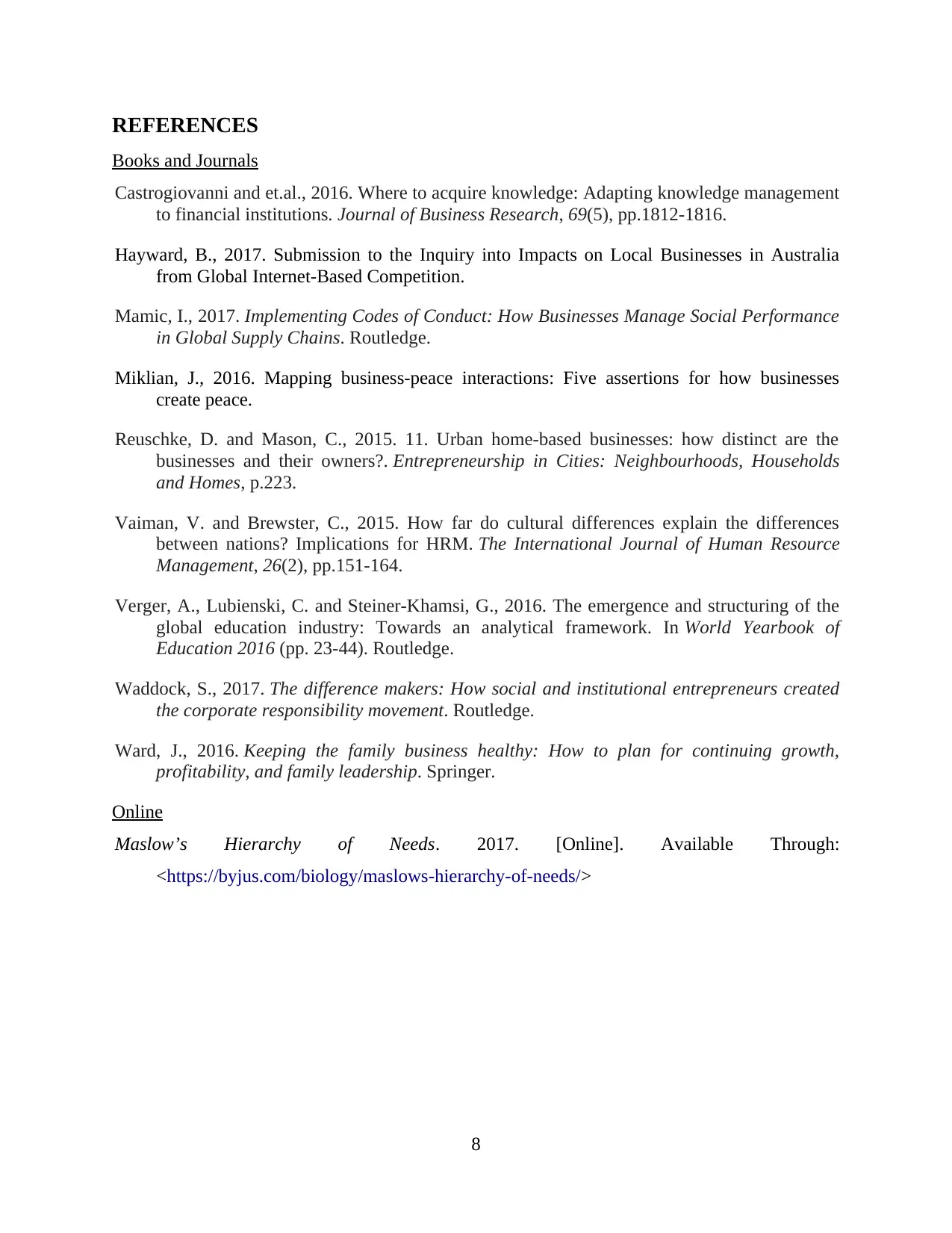
REFERENCES
Books and Journals
Castrogiovanni and et.al., 2016. Where to acquire knowledge: Adapting knowledge management
to financial institutions. Journal of Business Research, 69(5), pp.1812-1816.
Hayward, B., 2017. Submission to the Inquiry into Impacts on Local Businesses in Australia
from Global Internet-Based Competition.
Mamic, I., 2017. Implementing Codes of Conduct: How Businesses Manage Social Performance
in Global Supply Chains. Routledge.
Miklian, J., 2016. Mapping business-peace interactions: Five assertions for how businesses
create peace.
Reuschke, D. and Mason, C., 2015. 11. Urban home-based businesses: how distinct are the
businesses and their owners?. Entrepreneurship in Cities: Neighbourhoods, Households
and Homes, p.223.
Vaiman, V. and Brewster, C., 2015. How far do cultural differences explain the differences
between nations? Implications for HRM. The International Journal of Human Resource
Management, 26(2), pp.151-164.
Verger, A., Lubienski, C. and Steiner-Khamsi, G., 2016. The emergence and structuring of the
global education industry: Towards an analytical framework. In World Yearbook of
Education 2016 (pp. 23-44). Routledge.
Waddock, S., 2017. The difference makers: How social and institutional entrepreneurs created
the corporate responsibility movement. Routledge.
Ward, J., 2016. Keeping the family business healthy: How to plan for continuing growth,
profitability, and family leadership. Springer.
Online
Maslow’s Hierarchy of Needs. 2017. [Online]. Available Through:
<https://byjus.com/biology/maslows-hierarchy-of-needs/>
8
Books and Journals
Castrogiovanni and et.al., 2016. Where to acquire knowledge: Adapting knowledge management
to financial institutions. Journal of Business Research, 69(5), pp.1812-1816.
Hayward, B., 2017. Submission to the Inquiry into Impacts on Local Businesses in Australia
from Global Internet-Based Competition.
Mamic, I., 2017. Implementing Codes of Conduct: How Businesses Manage Social Performance
in Global Supply Chains. Routledge.
Miklian, J., 2016. Mapping business-peace interactions: Five assertions for how businesses
create peace.
Reuschke, D. and Mason, C., 2015. 11. Urban home-based businesses: how distinct are the
businesses and their owners?. Entrepreneurship in Cities: Neighbourhoods, Households
and Homes, p.223.
Vaiman, V. and Brewster, C., 2015. How far do cultural differences explain the differences
between nations? Implications for HRM. The International Journal of Human Resource
Management, 26(2), pp.151-164.
Verger, A., Lubienski, C. and Steiner-Khamsi, G., 2016. The emergence and structuring of the
global education industry: Towards an analytical framework. In World Yearbook of
Education 2016 (pp. 23-44). Routledge.
Waddock, S., 2017. The difference makers: How social and institutional entrepreneurs created
the corporate responsibility movement. Routledge.
Ward, J., 2016. Keeping the family business healthy: How to plan for continuing growth,
profitability, and family leadership. Springer.
Online
Maslow’s Hierarchy of Needs. 2017. [Online]. Available Through:
<https://byjus.com/biology/maslows-hierarchy-of-needs/>
8
1 out of 8
Related Documents
Your All-in-One AI-Powered Toolkit for Academic Success.
+13062052269
info@desklib.com
Available 24*7 on WhatsApp / Email
![[object Object]](/_next/static/media/star-bottom.7253800d.svg)
Unlock your academic potential
Copyright © 2020–2025 A2Z Services. All Rights Reserved. Developed and managed by ZUCOL.





